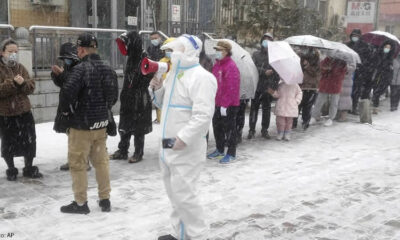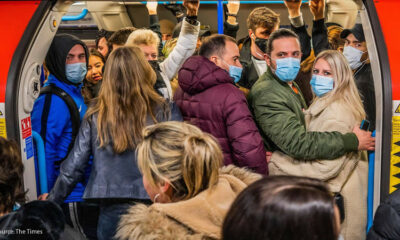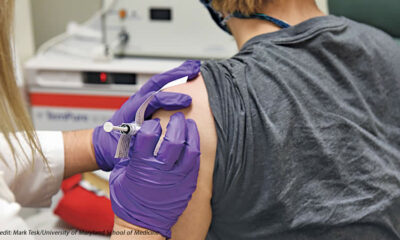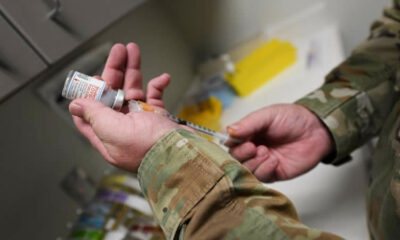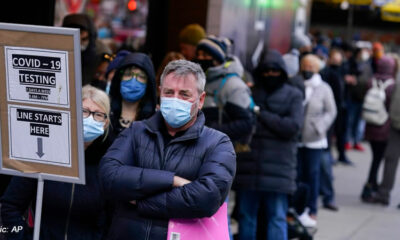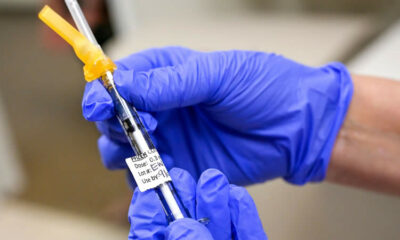Fitness
When Will Delta Variant in the United States Reach Its Peak
- Mathematical models predict that coronavirus cases in the United States will continue to rise until mid-October. The extent to which they rise depends upon people’s behaviors.
- The best clue to what’s in store for Americans comes from the United Kingdom, where the daily number of new infections has been declining for 7 days in a row.
- As with the U.K., the Delta variant now predominates in the U.S., accounting for over 8 out of every 10 cases.
Many people are wondering when the coronavirus outbreak will end, as instances of the highly contagious Delta form continue to grow significantly across the United States. Several mathematical models have been developed that attempt to predict the country’s pandemic future.
But, according to some experts, the best indicator of what lies ahead for Americans comes from the United Kingdom, where the daily number of new infections has dropped for the past seven days.
Many public health professionals projected that instances in the United Kingdom would continue to rise without showing any signs of near-term relief.
According to BBC News, some epidemiologists were warning of a “difficult summer” ahead for the United Kingdom as late as last week, with coronavirus cases potentially exceeding 100,000 or 200,000 per day.
There could be as many as 2,000 hospitalizations a day at this level, which according to experts would cause a “major disruption” to the country’s National Health Service (NHS).
The number of reported cases began to decline a few days after “freedom day” on July 19, when the country eliminated most remaining coronavirus restrictions after three countrywide lockdowns and nearly 130,000 deaths.
They fell for seven days before increasing for two days… and then falling slightly again on Friday.
In a country with high vaccination rates — over 68 percent of individuals have received at least one dose — and the Delta variation dominating new cases, the globe is now watching to see which direction cases will go in the coming weeks.
“Unfortunately, we will not be able to know if we are at a peak until we have passed it, probably by a few weeks,” Graham Medley, Ph.D., a professor at London School of Hygiene & Tropical Medicine, wrote in The Guardian.
If both cases and hospital admissions drop, “then we will be able to say that the day with lower cases 3 weeks earlier was just after the peak, but actually, the peak in infections was a week before that,” he wrote.
Even if the present U.K. government fails, Medley believes that the future of the country will be bright. When the spike peaks, there won’t be a gradual fall in cases across the country. Instead, he expects a series of diminishing peaks in various regions over the following few months, “like going over a range of hills.”
Models Predict Ongoing U.S. Surge Until Fall
Throughout much of the pandemic, U.K. has been a bellwether for the United States. However, there are distinctions between the countries that make it difficult to transfer the Delta variant experience from the United Kingdom to the United States.
The Delta variety now predominates in the United States, accounting for over 8 out of every 10 cases, just as it does in the United Kingdom.
However, the immunisation program in the United States has stalled, with only roughly 57.9% of Americans having received at least one dose of the COVID-19 vaccine. Vaccination rates also differ greatly across the country, with some counties still highly vulnerable to a Delta variant surge. Texas is one of those at-risk areas.
“There’s enough vulnerability in our population to have a surge that meets or exceeds what we saw last summer and winter,” said Dr. Spencer Fox, associate director of the UT COVID-19 Modeling Consortium, who helped develop projections for Texas.
“We’re seeing the combined impact of all of those factors right now,” he said.
Another COVID-19 model, which considers the entire United States, forecasts that coronavirus cases will grow throughout the summer and fall, peaking in mid-October.
This projection was released last week by the COVID-19 Scenario Modeling Hub. It combines 10 mathematical models from various groups of researchers to create an “ensemble” projection.
The group’s most recent projection considers four scenarios depending on vaccination rates and the spread of the dominant coronavirus strain.
Justin Lessler, Ph.D., an epidemiologist at the University of North Carolina who helps run the modeling hub, told NPR that in the most likely scenario, vaccination will top out at around 70 percent of eligible Americans and the most dominant variant will be highly transmissible, as we’ve seen with Delta.
In this scenario, the peak of the current surge will occur in mid-October, with roughly 59,000 cases and 850 deaths per day, the model shows.
This is just the middle of the range. In the worst-case scenario, COVID-19 could cause 246,000 infections and 4,500 deaths in the country during its peak in October.
Because numerous factors can affect the spread of the coronavirus and the associated COVID-19 hospitalizations and deaths, models like these have a wide range of possible outcomes.
However, the vaccines still offer strong protection against serious illness and death, which is why the vast majority of COVID-19 hospitalizations and deaths in the U.S. are now among the unvaccinated.
More immunizations indicate fewer individuals will be hospitalised or die as a result of COVID-19. Still, the effects of this renewed public interest in vaccination will take time to manifest.
“Vaccinations will not actually prevent the surge from happening, because we’re already in the midst of it,” said Fox. “It will take too long for immunity to be generated from the vaccines to prevent the surge — we’re already on the train barreling down the railway tracks.”
That’s why his group is calling for other public health measures to reduce the number of cases and hospitalizations in Texas, the source says.
“Our projections suggest that we will be straining healthcare capacity pretty imminently unless there’s a very strong behavioral change, where people — even those who are vaccinated — begin to take more precautions, such as wearing masks, social distancing, and avoiding nonessential and more risky activities,” said Fox.
Certain Factors Can Slow Delta Variant Surge
As the Delta variant outbreak spreads over much of the United States, efforts to restart the country’s delayed vaccination programme have resurfaced.
Another reason to take stronger measures to prevent the virus’s transmission is to reduce the risk that another, more dangerous, variant will arise.
“The biggest concern is that when the coronavirus is allowed to spread from person to person, there is a risk that the virus will mutate into a form that is no longer susceptible to the immune protection generated by the vaccines,” said Dr. Lewis S. Nelson, professor, and chair of emergency medicine at Rutgers New Jersey Medical School.
“We know vaccinations are going to be the most effective and safest way for us to get out of this pandemic,” said Fox.
“Vaccinations will not actually prevent the surge from happening, because we’re already in the midst of it,” said Fox. “It will take too long for immunity to be generated from the vaccines to prevent the surge — we’re already on the train barreling down the railway tracks.”
According to Health Line, that’s why his group is calling for other public health measures to reduce the number of cases and hospitalizations in Texas.
“Our projections suggest that we will be straining healthcare capacity pretty imminently unless there’s a very strong behavioral change, where people — even those who are vaccinated — begin to take more precautions, such as wearing masks, social distancing, and avoiding nonessential and more risky activities,” said Fox – according to the source.































































